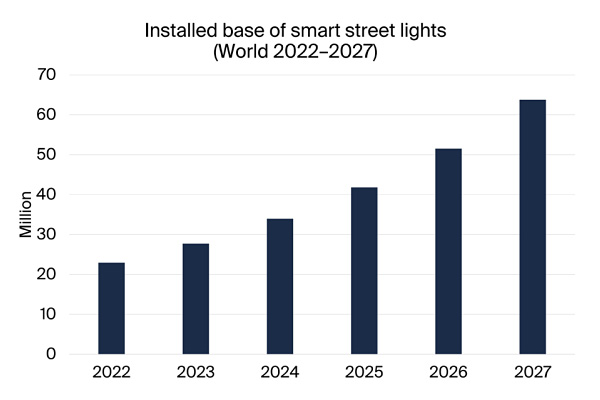
The installed base of smart street lights to reach 64 million worldwide by 2027


According to a new research report from the IoT analyst firm Berg Insight, the installed base of smart street lights amounted to 23.0 million globally at the end of 2022.
Growing at a compound annual growth rate (CAGR) of 22.7 percent, the installed base will reach 63.8 million by the end of 2027.
Europe leads the adoption of smart street lighting technology and accounted for as much as 35 percent of the global installed base in 2022. North America is catching up with Europe and is growing robustly, accounting for around 37 percent of global shipment volumes in 2022. China was at the same time home to almost half of the installed base of smart street lights outside Europe and North America.
The world’s leading smart street lighting vendor was as of Q3-2023 Signify which with nearly 4.9 million connected street lights accounted for 18 percent of the global installed base. The company climbed to pole position after acquiring the former market leader Telensa in July 2021. Included in the top three were also US-based Itron and the Chinese Fonda Technology, of which the latter has most of its lighting controllers deployed in the domestic market. In total, the top three vendors accounted for almost a third of the global installed base of individually controlled smart street lights. Itron furthermore also constitutes a global leader in the networking segment.

Major smart street lighting players also include Quantela, Dimonoff, Ubicquia and LED Roadway Lighting from North America; Schréder from Belgium; Rongwen Energy Technology Group from China; Revetec and Umpi from Italy; Flashnet (Lucy Group) from Romania; Lucy Zodion (Lucy Group) and SSE from the UK; and ST Engineering Telematics Wireless from Singapore/Israel.
“The smart street lighting market experienced significant growth in 2022 and the first quarters of 2023, after a slowdown during 2021 following supply chain constraints and delays in the issuance of tenders for new projects in the midst of the Covid-19 pandemic”, said William Ankreus, IoT analyst, Berg Insight.
Cities and municipalities have become increasingly aware of energy costs and environmental issues related to street lighting which has been a catalyst for growth in the smart street lighting market. While proprietary RF networking platforms have been the dominant connectivity type for smart street lighting deployments, the market is now clearly trending towards increased use of cellular communications in several parts of the world.
Mr. Ankreus continued:
“The simplicity and plug-and-play nature of cellular connectivity have made it an increasingly popular alternative for smart street lighting deployments and is expected to be the fastest growing connectivity technology”
The post The installed base of smart street lights to reach 64 million worldwide by 2027 appeared first on IoT Business News.


